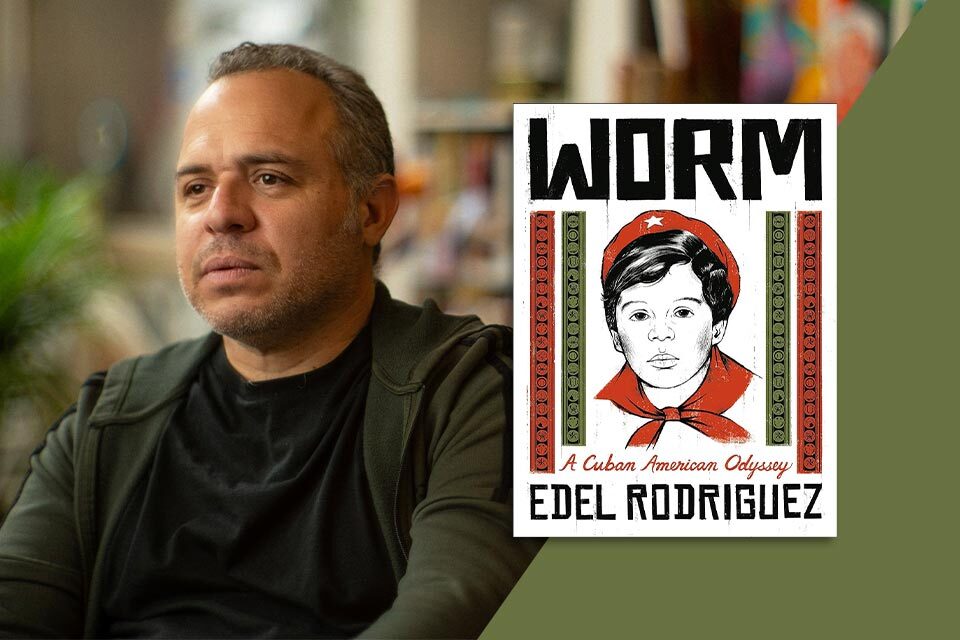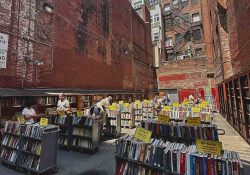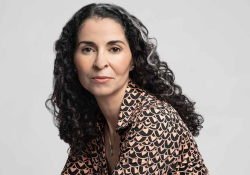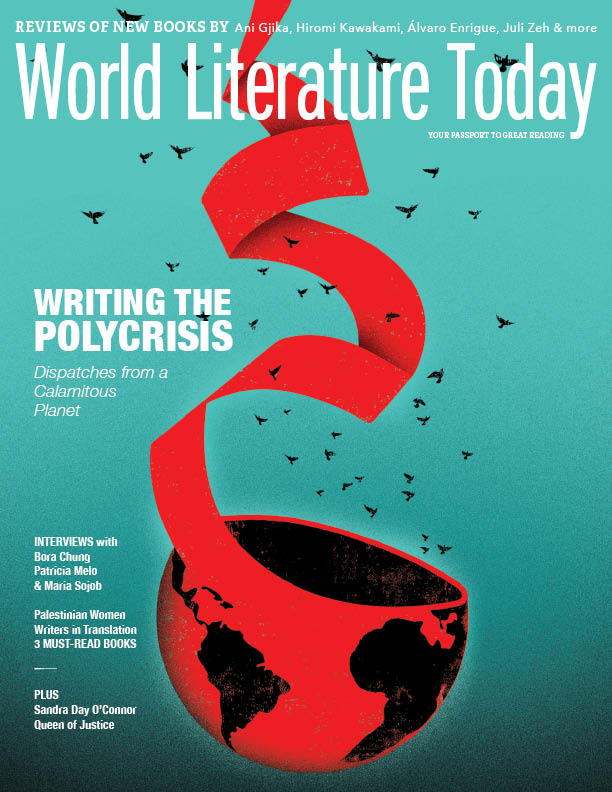Tying Art and Politics Together: A Conversation with Edel Rodriguez

In Worm: A Cuban American Odyssey (Metropolitan, 2023), acclaimed artist Edel Rodriguez illustrates a story of displacement, longing, and artistic awakening during his journey to America from childhood in Castro’s Cuba. Here, Rodriguez peels back the layers to his new graphic memoir and describes his process of conveying personal experiences through powerful visuals. His book is more than just a personal narrative and will leave you feeling inspired through stunning illustrations and uncomfortable truths.
Parker Buske: Worm opens with a vibrant depiction of your childhood in Cuba. What do you miss most about your early life there, and is there one memory that shapes your artistic sensibilities?
Edel Rodriguez: I miss my family and friends, the times we spent together, dancing, talking, and laughing on the porch, and the vibrant colors of my small town. My artistic sensibilities were shaped by scarcity, making do with what was at hand, and working with my hands at an early age. Watching my grandfather work as a carpenter, and helping him in the woodshop, helped shape me as an artist.
Buske: Your family left Cuba during the Mariel boatlift. Can you describe your emotions during this time, and how this experience shaped your perspective on immigration and displacement?
We should listen to people’s struggles and fears and do the most we can to help those who are in need at such a desperate time in their lives.
Rodriguez: Having been interned in a detention camp for days and setting out to sea during the boat lift definitely helped shape my views on immigration and displacement. Most people do not want to leave their homes. They do so as a last resort. We should listen to people’s struggles and fears and do the most we can to help those who are in need at such a desperate time in their lives.
Buske: Your new graphic memoir, Worm, tackles the challenges of understanding and navigating cultural identity. What were some of the biggest hurdles you faced as a young Cuban American, and how did you overcome them?
Rodriguez: The first difficulty was not being able to understand or speak a different language when I arrived here. I was placed in school with English speakers and had no idea what was going on most of the time. I eventually caught on and overcame the issue. Another difficulty was adapting to the American way of life. My parents had an elementary-school education and didn’t understand or plan for my time in college—I had to figure all of that out myself. I overcame that difficulty by focusing on the problem and speaking to my teachers and counselors about the issue. They were a lot of help and encouraged me to continue on my path to become an artist.
Buske: Worm explores the complex relationship between the two countries, Cuba and America. How has your understanding of both nations evolved over time?
Rodriguez: I feel that the Cuban government is a dictatorship and should be dealt with as such. Representative democracy and elections are the best way to peaceably solve a country’s problems, but there hasn’t been a free election in Cuba in over sixty years. I feel that cultural interchange and freedom of travel is the best way for people from different countries to understand one another. There was a brief period of time between 2015 and 2020 when it seemed that some significant change could happen in Cuba. However, in 2021 there was a nationwide protest in the country that was immediately quashed by the dictatorship. Many people were jailed, and the situation has become worse in the country since then. It’s difficult to find that optimism again.
Buske: In your book, you describe tensions between the Cuban government and the community. Could you explain how these tensions influenced your later political views and artistic expression?
Rodriguez: Cubans generally don’t speak about the government or politics. They tend to stay quiet and speak with only those they trust in hushed tones, usually in private. At some point, I saw similar behaviors in this country, folks afraid to speak up, or afraid to take a stand. It made me realize that I, as an artist, should use my position to speak up, make images that create discussion, and hopefully inspire others to express themselves freely.
As an artist, I use my position to speak up, make images that create discussion, and hopefully inspire others to express themselves freely.
Buske: The title Worm carries a layered meaning. How did the term evolve within the context of your story, and how does it ultimately reflect your personal and cultural identity?
Rodriguez: “Worm” (gusano) was a term used by Fidel Castro and those in the Communist party to describe and demean those who didn’t fit into their system. The term was used at Communist party rallies and yelled at people that dissented, disagreed with the system, or who wanted to leave the island. Many of us were shocked to hear that word and hurt by it, but over time many have decided to own it, to say, “Yes, I am against that system.”
Buske: As you began gaining leverage in the political and artistic community, how did you balance your work as an artist with your personal life and responsibilities as a father?
Rodriguez: Art is a part of my family’s life. I met my wife in art school, and my kids are both very artistic. One of them is now studying painting at the Pratt Institute, the same school my wife and I attended. My studio is in my home, so we are able to spend a lot of time together throughout the day. Working on my memoir did take a lot of time in the studio, but my family understood how important it was to tell this story. I regularly went to them for feedback, and they were very helpful throughout the entire process.
Buske: You seamlessly blend your personal narrative with political commentary in Worm. How did you develop this artistic approach, and what challenges did you face while conveying complex messages through visuals?
Rodriguez: My family’s life has always been affected in one way or another by politics, so bringing the two together was a matter of telling events as I remembered them. I made a lot of notes early on, both written and drawn. I then interviewed family members and friends, and went on to tie all of our stories together into what I felt was a compelling narrative that brought many disparate parts together. Conveying the stories through visuals felt like the easier or more joyful part of the process. I’ve had these images in my mind from the time I was a child; it was very fulfilling to finally have them come to life right before my eyes.
Buske: Your artwork has appeared on prominent platforms like Time magazine and has been used in political campaigns. What responsibilities do you feel as an artist, engaging with social and political issues?
Rodriguez: My main responsibilities as a visual artist who often deals with political issues is to communicate and inform, to get people to pay attention to many of the things that affect their lives, and to speak for those who can’t speak for themselves.
My main responsibilities as a visual artist is to communicate and inform, to get people to pay attention to many of the things that affect their lives, and to speak for those who can’t speak for themselves.
Buske: Given your success creating influential magazine cover designs, could you explain your artistic process while creating the cover for the March issue of World Literature Today, Writing the Polycrisis?
Rodriguez: My usual process is to create a number of small sketches, bouncing ideas on the paper, back and forth. I try to get at the essence of the story by telling myself stories, sometimes literally saying out loud “this is about the planet coming apart,” then illustrating that. Once you have the main thrust, ideas start to flow. The planet can break apart like a bowl, melt, burn, or peel away. Ultimately it was that image, of a peeling planet, that best described visually what is happening to the planet right now.
Buske: What advice would you give to aspiring artists and storytellers who want to use their platform to create socially impactful work?
Rodriguez: My advice is to read, to understand, to become engaged with the issues. The best artists who create socially impactful work are ones that are educated on the subjects they are depicting. Make personal work, experiment in the studio, do something radical and unexpected, then bring some of those experiments into your posters, magazine covers, and other commissioned work. That is the best way to imbue the work with your own emotions and personality.
February 2024
Edel Rodriguez was born in Havana, Cuba, in 1971. In 1980 Rodriguez and his family boarded a boat and left for America during the Mariel boatlift. Rodriguez has illustrated hundreds of magazine and book covers for clients such as Time, Der Spiegel, and Penguin Books and has illustrated poster and advertising campaigns for many operas, films, and Broadway shows. His memoir Worm: A Cuban American Odyssey was published by Metropolitan Books / Henry Holt in 2023.











